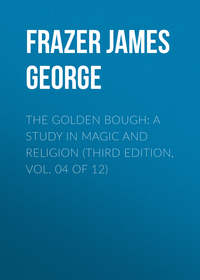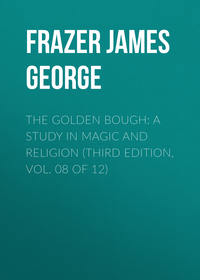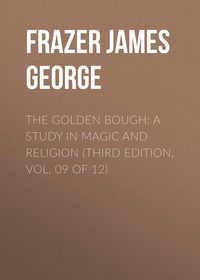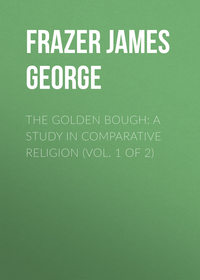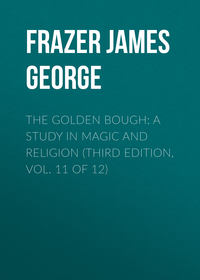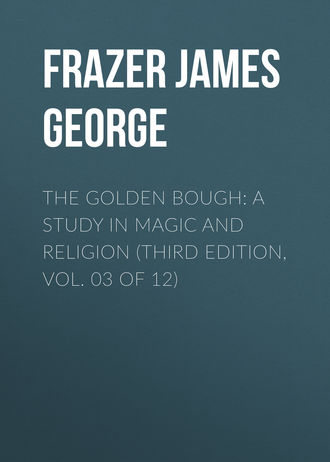 полная версия
полная версияThe Golden Bough: A Study in Magic and Religion (Third Edition, Vol. 03 of 12)
1422
R. Baron, “The Bara,” Antananarivo Annual and Madagascar Magazine, vol. ii., Reprint of the Second Four Numbers (Antananarivo, 1896), p. 83.
1423
A. Grandidier, “Madagascar,” Bulletin de la Société de Géographie (Paris), Vme Série, xvii. (1869) pp. 401 sq. The writer is here speaking specially of the Sakalavas, though his remarks appear to be of general application.
1424
J. S. Polack, Manners and Customs of the New Zealanders, i. 37 sq., ii. 126 sq. Compare E. Tregear, “The Maoris of New Zealand,” Journal of the Anthropological Institute, xix. (1890) p. 123.
1425
Captain J. Cook, Voyages (London, 1809), vi. 155 (Third Voyage). Compare Captain James Wilson, Missionary Voyage to the Southern Pacific Ocean (London, 1799), p. 366; W. Ellis, Polynesian Researches,2 iii. 101.
1426
Vancouver, Voyage of Discovery to the North Pacific Ocean and round the World (London, 1798), i. 135.
1427
United States Exploring Expedition, Ethnography and Philology, by Horatio Hale (Philadelphia, 1846), pp. 288 sq.
1428
G. Brown, D.D., Melanesians and Polynesians (London, 1910), p. 280.
1429
Lucian, Lexiphanes, 10. The inscriptional and other evidence of this Greek superstition was first brought to the notice of anthropologists by Mr. W. R. Paton in an interesting article, “The Holy Names of the Eleusinian Priests,” International Folk-lore Congress, 1891, Papers and Transactions, pp. 202-214. Compare E. Maass, Orpheus (Munich, 1895), p. 70; Aug. Mommsen, Feste der Stadt Athen im Altertum (Leipsic, 1898), pp. 253-255; P. Foucart, Les Grands Mystères d'Eleusis (Paris, 1900), pp. 28-31. The two last writers shew that, contrary to what we might have expected, the custom appears not to have been very ancient.
1430
G. Kaibel, Epigrammata Graeca ex lapidibus conlecta, No. 863; Ἐφημερὶς ἀρχαιολογική, 1883, col. 79 sq. From the latter of these inscriptions we learn that the name might be made public after the priest's death. Further, a reference of Eunapius (Vitae sophistarum, p. 475 of the Didot edition) shews that the name was revealed to the initiated. In the essay cited in the preceding note Mr. W. R. Paton assumes that it was the new and sacred name which was kept secret and committed to the sea. The case is not clear, but both the evidence and the probability seem to me in favour of the view that it was rather the old everyday name of the priest or priestess which was put away at his or her consecration. If, as is not improbable, these sacred personages had to act the parts of gods and goddesses at the mysteries, it might well be deemed indecorous and even blasphemous to recall the vulgar names by which they had been known in the familiar intercourse of daily life. If our clergy, to suppose an analogous case, had to personate the most exalted beings of sacred history, it would surely be grossly irreverent to address them by their ordinary names during the performance of their solemn functions.
1431
H. Seidel, “Der Yew'e Dienst im Togolande,” Zeitschrift für afrikanische und oceanische Sprachen, iii. (1897) pp. 161-173; H. Klose, Togo unter deutscher Flagge (Berlin, 1899), pp. 197-205. Compare Lieut. Herold, “Bericht betreffend religiöse Anschauungen und Gebräuche der deutschen Ewe-Neger,” Mittheilungen aus den deutschen Schutzgebieten, v. (1892) p. 146; J. Spieth, “Der Jehve Dienst der Evhe-Neger,” Mittheilungen der Geographischen Gesellschaft zu Jena, xii. (1893) pp. 83-88; C. Spiess, “Religionsbegriffe der Evheer in Westafrika,” Mittheilungen des Seminars für orientalische Sprachen zu Berlin, vi. (1903) Dritte Abtheilung, p. 126.
1432
Spencer and Gillen, Northern Tribes of Central Australia, p. 227.
1433
G. Timkowski, Travels of the Russian Mission through Mongolia to China (London, 1827), ii. 348.
1434
J. Campbell, Travels in South Africa, Second Journey (London, 1822), ii. 204 sq.
1435
P. Rascher, “Die Sulka, ein Beitrag zur Ethnographie Neu-Pommern,” Archiv für Anthropologie, xxix. (1904) p. 216. Compare R. Parkinson, Dreissig Jahre in der Südsee, p. 198.
1436
Washington Matthews, “The Mountain Chant, a Navajo Ceremony,” Fifth Annual Report of the Bureau of Ethnology (Washington, 1887), pp. 386 sq.
1437
L. H. Morgan, League of the Iroquois (Rochester, U.S., 1851), pp. 167 sq. The writer derives the prohibition to tell tales of wonder in summer “from a vague and indefinable dread.”
1438
H. R. Schoolcraft, Indian Tribes, iii. 314, 492.
1439
K. Vetter, in Mittheilungen der Geographischen Gesellschaft zu Jena, xii. (1893) p. 95; id., Komm herüber und hilf uns! ii. (Barmen, 1898) p. 26; B. Hagen, Unter den Papuas (Wiesbaden, 1898), p. 270. On myths or magical tales told as spells to produce the effects which they describe, compare F. Kauffmann, Balder (Strasburg, 1902), pp. 299 sqq.; C. Fossey, La Magie assyrienne (Paris, 1902), pp. 95-97.
1440
Fr. Boas, “The Social Organization and the Secret Societies of the Kwakiutl Indians,” Report of the U.S. National Museum for 1895, pp. 396, 418 sq., 503, 504. Compare Totemism and Exogamy, iii. 333 sq., 517 sq.
1441
Xenophanes, quoted by Eusebius, Praeparatio Evangelii, xiii. 13, pp. 269 sq., ed. Heinichen, and by Clement of Alexandria, Strom. vii. 4, pp. 840 sq., ed. Potter; H. Diels, Die Fragmente der Vorsokratiker2 (Berlin, 1906-1910), i. 49.
1442
A. Erman, Ägypten und ägyptisches Leben im Altertum, pp. 359-362; A. Wiedemann, Die Religion der alten Ägypter, pp. 29-32; G. Maspero, Histoire ancienne des peuples de l'Orient classique: les origines, pp. 162-164; R. V. Lanzone, Dizionario di mitologia egizia (Turin, 1881-1884), pp. 818-822; E. A. Wallis Budge, The Book of the Dead (London, 1895), pp. lxxxix. – xci.; id., Egyptian Magic, pp. 136 sqq.; id., The Gods of the Egyptians (London, 1904), i. 360 sq. The abridged form of the story given in the text is based on a comparison of these various versions, of which Erman's is slightly, and Maspero's much curtailed. Mr. Budge's version is reproduced by Mr. E. Clodd (Tom Tit Tot, pp. 180 sqq.).
1443
G. Maspero, Études de mythologie et d'archéologie égyptienne (Paris, 1893), ii. 297 sq.
1444
E. Lefébure, “La Vertu et la vie du nom en Égypte,” Mélusine, viii. (1897) coll. 227 sq. Compare A. Erman, Ägypten und ägyptisches Leben im Altertum, pp. 472 sq.; E. A. Wallis Budge, Egyptian Magic, pp. 157 sqq.
1445
Lucan, Pharsalia, vi. 730 sqq.
1446
E. W. Lane, Manners and Customs of the Ancient Egyptians (Paisley and London, 1895), ch. xii. p. 273.
1447
E. Doutté, Magie et religion dans l'Afrique du nord, p. 130.
1448
J. J. M. de Groot, The Religious System of China, vi. (Leyden, 1910) p. 1126.
1449
Pliny, Nat. Hist. xxviii. 18; Macrobius, Saturn. iii. 9; Servius on Virgil, Aen. ii. 351; Plutarch, Quaest. Rom. 61. According to Servius (l. c.) it was forbidden by the pontifical law to mention any Roman god by his proper name, lest it should be profaned. Compare Festus, p. 106, ed. C. O. Müller: “Indigetes dii quorum nomina vulgari non licet.” On the other hand the Romans were careful, for the sake of good omen, to choose men with lucky names, like Valerius, Salvius, Statorius, to open any enterprise of moment, such as to lead the sacrificial victims in a religious procession or to be the first to answer to their names in a levy or a census. See Cicero, De divinatione, i. 45. 102 sq.; Festus, s. v. “Lacus Lucrinus,” p. 121, ed. C. O. Müller; Pliny, Nat. Hist. xxviii. 22; Tacitus, Histor. iv. 53.
1450
Pliny, Nat. Hist. iii. 65; Solinus, i. 4 sq.; Macrobius, Sat. iii. 9, 3, and 5; Servius, on Virgil, Aen. i. 277; Joannes Lydus, De mensibus, iv. 50.
1451
F. Fossey, La Magie assyrienne (Paris, 1902), pp. 58, 95.
1452
T. de Pauly, Description ethnographique des peuples de la Russie (St. Petersburg, 1862), Peuples ouralo-altaïques, p. 24.
1453
M. Martin, “Description of the Western Islands of Scotland,” in Pinkerton's Voyages and Travels, iii. 579 sq. As to the Flannan Islands see also Sir J. Sinclair's Statistical Account of Scotland, xix. (Edinburgh, 1797), p. 283.
1454
J. G. Campbell, Superstitions of the Highlands and Islands of Scotland (Glasgow, 1900), p. 239.
1455
Miss Morag Cameron, “Highland Fisher-folk and their Superstitions,” Folk-lore, xiv. (1903) p. 304.
1456
A. Edmonston, Zetland Islands (Edinburgh, 1809), ii. 74.
1457
Ch. Rogers, Social Life in Scotland (Edinburgh, 1884-1886), iii. 218.
1458
W. Gregor, Folk-lore of the North-East of Scotland, pp. 199-201.
1459
“Traditions, Customs, and Superstitions of the Lewis,” Folk-lore, vi. (1895) p. 170; Miss A. Goodrich-Freer, “The Powers of Evil in the Outer Hebrides,” Folk-lore, x. (1899) p. 265.
1460
J. Mackenzie, Ten Years north of the Orange River (Edinburgh, 1871), p. 151, note 1.
1461
J. G. Campbell, Witchcraft and Second Sight in the Highlands and Islands of Scotland (Glasgow, 1902), pp. 184 sq.
1462
J. Rhys, “Manx Folk-lore and Superstitions,” Folk-lore, iii. (1892) p. 84.
1463
A. Bosquet, La Normandie romanesque et merveilleuse (Paris and Rouen, 1845), p. 308.
1464
J. G. Gmelin, Reise durch Sibirien, ii. (Göttingen, 1752), p. 277
1465
Bavaria, Landes- und Volkskunde des Königreichs Bayern, ii. (Munich, 1863), p. 304.
1466
Tettau und Temme, Die Volkssagen Ostpreussens, Litthauens und Westpreussens (Berlin, 1837), p. 281.
1467
W. Witzschel, Sagen, Sitten, und Gebräuche aus Thüringen, p. 175, § 30.
1468
K. Bartsch, Sagen, Märchen, und Gebräuche aus Meklenburg, ii. p. 246, §§ 1273, 1274.
1469
A. Kuhn, Märkische Sagen und Märchen, p. 378, § 14.
1470
B. Thorpe, Northern Mythology, ii. 83 sq.; L. Lloyd, Peasant Life in Sweden (London, 1870), p. 251.
1471
R. F. Kaindl, Die Huzulen (Vienna, 1894), p. 103; id., “Viehzucht und Viehzauber in den Ostkarpaten,” Globus, lxix. (1896) p. 387.
1472
Id., “Neue Beiträge zur Ethnologie und Volkskunde der Huzulen,” Globus, lxix. (1896) p. 73.
1473
C. Leemius, De Lapponibus Finmarchiae eorumque lingua, vita, et religione pristina commentatio (Copenhagen, 1767), pp. 502 sq.
1474
M. A. Castren, Vorlesungen über die finnische Mythologie (St. Petersburg, 1853), p. 201.
1475
Varonen, reported by Hon. J. Abercromby in Folk-lore, ii. (1891) pp. 245 sq.
1476
Boecler-Kreutzwald, Der Ehsten abergläubische Gebräuche, Weisen und Gewohnheiten, p. 120.
1477
P. Labbé, Un Bagne russe, l'île de Sakhaline (Paris, 1903), p. 231.
1478
G. W. Steller, Beschreibung von dem Lande Kamtschatka (Frankfort and Leipsic, 1774), p. 276.
1479
G. W. Steller, op. cit. p. 91; compare ib. pp. 129, 130.
1480
J. Mooney, “Sacred Formulas of the Cherokees,” Seventh Annual Report of the Bureau of Ethnology (Washington, 1892), p. 352. Compare id., “Myths of the Cherokee,” Nineteenth Annual Report of the Bureau of American Ethnology, Part i. (Washington, 1900) p. 295.
1481
E. W. Nelson, “The Eskimo about Bering Strait,” Eighteenth Annual Report of the Bureau of American Ethnology, Part i. (Washington, 1899) p. 438.
1482
F. Boas, “The Eskimo of Baffin Land and Hudson Bay,” Bulletin of the American Museum of Natural History, xv. (1901) p. 148.
1483
J. Teit, “The Thompson Indians of British Columbia,” Memoir of the American Museum of Natural History, The Jesup North Pacific Expedition, vol. i. part iv. (April 1900) p. 374.
1484
J. Wellhausen, Reste arabischen Heidentums2 (Berlin, 1897), p. 199.
1485
A. Certeux et E. H. Carnoy, L'Algérie traditionnelle (Paris and Algiers, 1884), pp. 172, 175.
1486
Father Picarda, “Autour de Mandéra,” Missions Catholiques, xviii. (1886) p. 227.
1487
J. J. Monteiro, Angola and the River Congo (London, 1875), ii. 116.
1488
J. Mackenzie, Ten Years north of the Orange River (Edinburgh, 1871), p. 151; C. R. Conder, in Journal of the Anthropological Institute, xvi. (1887) p. 84.
1489
H. B. Johnstone, “Notes on the Customs of the Tribes occupying Mombasa Sub-district, British East Africa,” Journal of the Anthropological Institute, xxxii. (1902) p. 268.
1490
J. J. M. de Groot, The Religious System of China, v. (Leyden, 1907) p. 691.
1491
A. F. Mockler-Ferryman, British Nigeria (London, 1902), p. 285.
1492
J. Irle, Die Herero (Gütersloh, 1906), p. 133.
1493
A. C. Hollis, The Nandi (Oxford, 1909), p. 43.
1494
H. F. Standing, “Malagasy fady,” Antananarivo Annual and Madagascar Magazine, vol. ii., Reprint of the Second Four Numbers (Antananarivo, 1896), p. 258.
1495
H. F. Standing, op. cit. p. 263.
1496
J. Sibree, The Great African Island, pp. 307 sq.
1497
R. H. Nassau, Fetichism in West Africa (London, 1904), pp. 381 sqq.
1498
Panjab Notes and Queries, i. p. 15, § 122.
1499
North Indian Notes and Queries, i. p. 104, § 690.
1500
Id. v. p. 133, § 372.
1501
W. Crooke, Popular Religion and Folk-lore of Northern India (Westminster, 1896), ii. 142 sq.
1502
S. Mateer, Native Life in Travancore, pp. 320 sq.
1503
North Indian Notes and Queries, v. p. 133, § 372.
1504
W. Crooke, op. cit. ii. 212.
1505
W. Crooke in North Indian Notes and Queries, i. p. 70, § 579; id., Tribes and Castes of the North-Western Provinces and Oudh, iii. 249; id., Popular Religion and Folk-lore of Northern India (Westminster, 1896), ii. 54.
1506
W. Crooke, Tribes and Castes of the North-Western Provinces and Oudh, iii. 314.
1507
D. Sunder, “Exorcism of Wild Animals in the Sundarbans,” Journal of the Asiatic Society of Bengal, lxxii. part iii. (Calcutta, 1904) pp. 45 sqq., 51.
1508
H. Mouhot, Travels in the Central Parts of Indo-China (London, 1864), i. 263 sq.
1509
Mgr Masson, in Annales de la Propagation de la Foi, xxiv. (1852) p. 323. Compare Le R. P. Cadière, “Croyances et dictons populaires de la vallée du Nguôn-son,” Bulletin de l'École Française d'Extrême-Orient, i. (1901) p. 134.
1510
E. Young, The Kingdom of the Yellow Robe (Westminster, 1898), p. 61.
1511
N. Annandale, “Primitive Beliefs and Customs of the Patani Fishermen,” Fasciculi Malayenses, Anthropology, part i. (April 1903) p. 104.
1512
E. Aymonier, Notes sur le Laos, p. 113; id., Voyage dans le Laos, i. (Paris, 1895) p. 311. In the latter passage the writer observes that the custom of giving conventional names to common objects is very generally observed in Indo-China during the prosecution of long and perilous journeys undertaken periodically.
1513
Id., “Les Tchames et leurs religions,” Revue de l'Histoire des Religions, xxiv. (1891) p. 278. Compare A. Cabaton, Nouvelles Recherches sur les Chams (Paris, 1901), p. 53.
1514
D. F. A. Hervey, in Indian Notes and Queries (December 1886), p. 45, § 154.
1515
Pantang is equivalent to taboo. In this sense it is used also by the Dyaks. See S. W. Tromp, “Een Dajaksch Feest,” Bijdragen tot de Taal- Land- en Volkenkunde van Nederlandsch-Indië, xxxix. (1890) pp. 31 sq.
1516
J. R. Logan, “The Orang Binua of Johore,” Journal of the Eastern Archipelago and Eastern Asia, i. (1847) pp. 249, 263-265; A. Bastian, Die Völker des östlichen Asien, v. 37; H. Lake and H. J. Kelsall, “The Camphor Tree and Camphor Language of Johore,” Journal of the Straits Branch of the Royal Asiatic Society, No. 26 (January 1894), pp. 39 sq.; W. W. Skeat, Malay Magic, pp. 212-214; W. W. Skeat and C. O. Blagden, Pagan Races of the Malay Peninsula (London, 1906), ii. 414-431.
1517
C. M. Pleyte, “Herinneringen uit Oost-Indië,” Tijdschrift van het koninklijk Nederlandsch Aardrijkskundig Genootschap, II Serie, xvii. (1900) pp. 27 sq.
1518
W. H. Furness, Folk-lore in Borneo (Wallingford, Pennsylvania, 1899; privately printed), p. 27; id., Home-life of Borneo Head-hunters (Philadelphia, 1902), p. 17. A special language is also used in the search for camphor by some of the natives of Sumatra. See Th. A. L. Heyting, “Beschrijving der onder-afdeeling Groot-Mandeling en Batang-Natal,” Tijdschrift van het Nederlandsch Aardrijkskundig Genootschap, Tweede Serie, xiv. (1897) p. 276.
1519
W. H. Furness, Home-life of Borneo Head-hunters, pp. 168 sq.
1520
W. W. Skeat, Malay Magic, pp. 250, 253-260. In like manner the people of Sikhim intensely dread all mining operations, believing that the ores and veins of metals are the stored treasures of the earth-spirits, who are enraged by the removal of these treasures and visit the robbers with sickness, failure of crops, and other calamities. Hence the Sikhimese leave the copper mines to be worked by Nepaulese. See L. A. Waddell, Among the Himalayas (Westminster, 1899), p. 101.
1521
W. W. Skeat, op. cit. pp. 139 sq.
1522
W. W. Skeat, op. cit. pp. 192 sq.
1523
N. Annandale, “Primitive Beliefs and Customs of the Patani Fishermen,” Fasciculi Malayenses, Anthropology, part i. (April 1903) pp. 84-86.
1524
C. Snouck Hurgronje, De Atjèhers (Batavia and Leyden, 1893-1894), i. 303.
1525
J. L. van der Toorn, “Het animisme bij den Minangkabauer der Padangsche Bovenlanden,” Bijdragen tot de Taal- Land- en Volkenkunde van Nederlandsch-Indië, xxxix. (1890) p. 100. As to the superstitions of gold-washers among the Gayos of Sumatra, see C. Snouck Hurgronje, Het Gajoland en zijne Bewoners (Batavia, 1903), pp. 361 sq.
1526
M. T. H. Perelaer, Ethnographische Beschrijving der Dajaks (Zalt-Bommel, 1870), p. 215.
1527
J. T. Nieuwenhuisen en H. C. B. von Rosenberg, “Verslag omtrent het eiland Nias,” Verhandelingen van het Bataviaasch Genootschap van Kunsten en Wetenschappen, xxx. (1863) p. 115. Compare W. Marsden, History of Sumatra, p. 292; T. J. Newbold, Account of the British Settlements in the Straits of Malacca, ii. 192 sq.
1528
J. E. Neumann, “Kemali, Pantang en Rèboe bij de Karo-Bataks,” Tijdschrift voor Indische Taal- Land- en Volkenkunde, xlviii. (1906) pp. 511 sq.
1529
C. Snouck Hurgronje, Het Gajoland en zijne Bewoners (Batavia, 1903), pp. 311 sq.
1530
J. W. Thomas, “De jacht op het eiland Nias,” Tijdschrift voor Indische Taal- Land- en Volkenkunde, xxvi. (1880) p. 275.
1531
L. N. H. A. Chatelin, “Godsdienst en bijgeloof der Niassers,” Tijdschrift voor Indische Taal- Land- en Volkenkunde, xxvi. (1880) p. 165; H. Sundermann, “Die Insel Nias und die Mission daselbst,” Allgemeine Missions-Zeitschrift, xi. (1884) p. 349; E. Modigliani, Un Viaggio a Nias (Milan, 1890), p. 593.
1532
A. L. van Hasselt, “Nota, betreffende de rijstcultuur in de Residentie Tapanoeli,” Tijdschrift voor Indische Taal- Land- en Volkenkunde, xxxvi. (1893) pp. 525 sq. The Singhalese also call things by strange names when they are in the rice-fields. See A. A. Perera, “Glimpses of Singhalese Social Life,” Indian Antiquary, xxxii. (1903) p. 437.
1533
G. A. J. Hazeu, “Kleine Bijdragen tot de Ethnografie en de Folk-lore van Java,” Tijdschrift voor Indische Taal- Land- en Volkenkunde, xlvii. (1903) pp. 291 sq.


